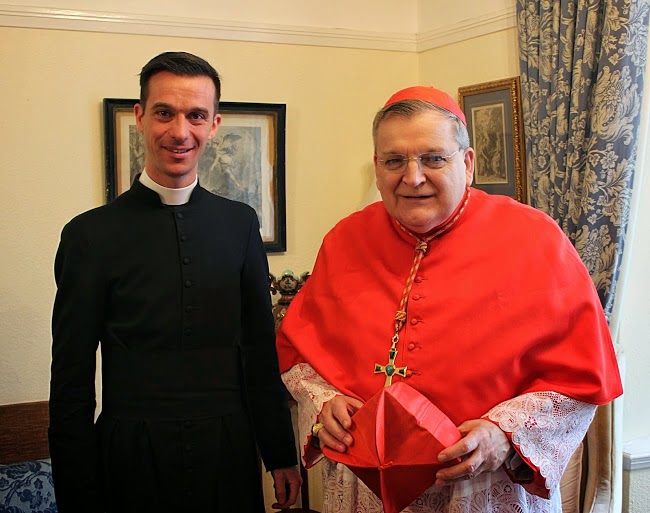On February 14, 2015, Bishop Athanasius Schneider of Astana, Kazakhstan, gave a talk in Washington, DC. During the talk, he proposed concrete actions — ten essential elements — which should be implemented to accomplish liturgical renewal. I like them all! Of course, many of these can be accomplished immediately in the Ordinary Form of the Mass by simply following the rubrics and exercising the variations that are allowed. Ways to celebrate Holy Week and Easter even more gloriously this year!
1. The tabernacle, where Jesus Christ, the Incarnate God, is really present under the species of bread should be placed in the centre of the sanctuary, because in no other sign on this earth is God, the Emmanuel, so really present and so near to man as in the tabernacle. The tabernacle is the sign indicating and containing the Real Presence of Christ and should therefore be closer to the altar and constitute with the altar the one central sign indicating the Eucharistic mystery. The Sacrament of the Tabernacle and the Sacrifice of the Altar should therefore not be opposed or separated, but both in the central place and close together in the sanctuary. All the attention of those who enter a church should spontaneously be directed towards the tabernacle and the altar.
2. During the Eucharistic liturgy – at the very least during the Eucharistic prayer – when Christ the Lamb of God is immolated, the face of the priest should not be seen by the faithful. Even the Seraphim cover their faces (Isaiah 6:2) when adoring God. Instead, the face of the priest should be turned toward the cross, the icon of the crucified God.
3. During the liturgy, there should be more signs of adoration — specifically genuflections — especially each time the priest touches the consecrated host.
4. The faithful approaching to receive the Lamb of God in Holy Communion should greet and receive Him with an act of adoration, kneeling. Which moment in the life of the faithful is more sacred than this moment of encounter with the Lord?
5. There should be more room for silence during the liturgy, especially during those moments which most fully express the mystery of the redemption. Especially when the sacrifice of the cross is made present during the Eucharistic prayer.
6. There should be more exterior signs which express the dependence of the priest on Christ, the High Priest, which would more clearly show that the words the priest speaks (ie., “Dominus Vobiscum“) and the blessings he offers to the faithful depend on and flow out from Christ the High Priest, not from him, the private person. Not “I greet you” or “I bless you” but “I the Lord” do these things. Christ. Such signs could be (as was practiced for centuries) the kissing of the altar before greeting the people to indicate that this love flows not from the priest but from the altar; and also before blessing, to kiss the altar, and then bless the people. (This was practiced for millennium, and unfortunately in the new rite has been abolished.) Also, bowing towards the altar cross to indicate that Christ is more important than the priest. Often in the liturgy — in the old rite — when a priest expressed the name of Jesus, he had to turn to the cross and make a bow to show that the attention should be on Christ, not him.
7. There should be more signs which express the unfathomable mystery of the redemption. This could be achieved through the veiling of liturgical objects, because veiling is an act of the liturgy of the angels. Veiling the chalice, veiling the paten with the humeral veil, the veiling of the corporal, veiling the hands of the bishop when he celebrates a solemnity, The use of communion rails, also, to veil the altar. Also signs – signs of the cross by the priest and the faithful. Making signs of the cross during the priest by the Eucharistic prayer and by the faithful during other moments of the liturgy; when we are signing ourselves with the cross it is a sign of blessing. In the ancient liturgy, three times during the Gloria, the Credo, and the Sanctus, the faithful made the sign of the cross. These are expressions of the mystery.
8. There should be a constant sign which expresses the mystery also by means of human language – that is to say, Latin is a sacred language demanded by the Second Vatican Council in celebration of every holy Mass and in each place a part of the Eucharistic prayer should always be said in Latin.
9. All those who exercise an active role in the liturgy, such as lectors, or those announcing the prayer of the faithful, should always be dressed in the liturgical vestments; and only men, no women, because this is an exercise in the sanctuary, close to the priesthood. Even reading the lectionary is directed towards this liturgy which we are celebrating to Christ. And therefore only men dressed in liturgical vestments should be in the sanctuary.
10. The music and the songs during the liturgy should more truly reflect the sacred character and should resemble the song of the angels, like the Sanctus, in order to be really more able to sing with one voice with the angels. Not only the Sanctus, but the entire Holy Mass. It would be necessary that the heart, mind and voice of the priest and the faithful be directed towards The Lord. And that this would be manifested by exterior signs and gestures as well.
Thanks to
One Peter Five, where I found the report of the Bishop's talk.































































